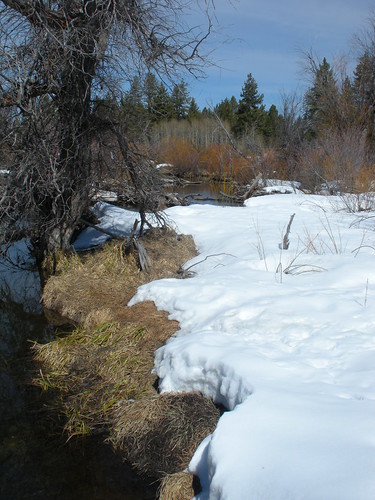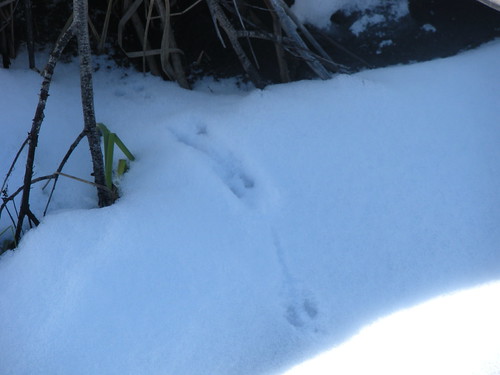We tried to focus on finding signs of mammals on our hike as part of the Winter Series Challenge for mammals.

The squirrels have been busy munching on cones.

Isn't this just the most wonderful cone you have seen in a long time?

The snow is melting a little on this familiar hike. The beaver dam is still visible with all the leaves gone from the trees and bushes.

Here you can see the snow pulling away from the creek water and exposing the grasses underneath. It feels like spring here for the first time.

I am thinking these are dog tracks but perhaps coyote since we have seen them in this area before.

Now these I am pretty sure are rabbit tracks...or perhaps snowshoe hare tracks.

We spotted this trail of tracks to the left of the snowy log and if you look carefully you can see them disappear in the distance. I have no idea who made them but they were fun to see and to talk about.

Here are some more tracks down by an icy spot on the creek.
We came home and decided to look up and learn about a mammal from our field guide. There are quite a few to choose from that live in this particular area, but we chose the Douglas squirrel (or Chickaree). We often hear squirrels in the trees and now we know that in this particular area, the only tree squirrel is the Douglas squirrel. They have a chattering sound that is distinct, making it easier to identify even if we don't actually see them in the trees. Our mammal field guide says that they are active all year long, but they still store a winter cache of cones. We also learned that the piles of leftovers where a squirrel eats are called middens. There is an actual name for those piles we see under trees!
We used this online book to learn more about our local mammals: Nature Guide to...
Wikipedia Article: Douglas squirrel
Link to its tracks at BearTracker: Douglas squirrel
This site has some great images: Nature Works
"Nature has made him master forester and committed most of her coniferous crops to his paws. Probably over fifty percent of all the cones ripened on the Sierra are cut off and handled by the Douglas alone, and of those of the Big Trees perhaps ninety percent pass through his hands."Isn't that interesting? I love when we take a few minutes to learn a little more about something in our nature study that really is meaningful and will help us understand our local environment better.
John Muir on Douglas squirrels, The Mountains of California.
This was a great challenge for us this time around.
Barb-Harmony Art Mom
